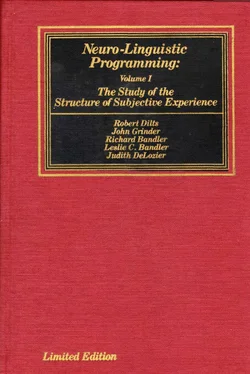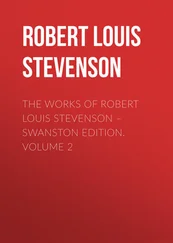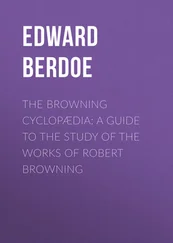Step 3. Utilize the creative strategy you have elicited as a resource for the situation by having him reprocess the experiences, either experientially on the spot or through imagination and memory, in terms of his creativity strategy. Direct him through his creativity strategy by having him reconsider the situation through the representational sequence that he runs through when he is creative. In doing so the person will automatically generate, or create, a number of new possible choices.
For instance, suppose the person you are working with is a business executive who has a creativity strategy that goes:

In this strategy the person would begin by looking externally at the significant components in the situation (V e). He would then begin to talk to himself about the object or components (A i d); how
they operate together; asking what kind of resources may be required for the situation; perhaps describing some incident from his personal history that was similar to the situation he is facing now. As he talks he gets a feeling about each of the verbalizations (K i) which indicates to him whether the direction of the thought is appropriate or not to the situation in question. If the feeling is negative, executive will operate by looking back out at the situation, talking about it and feeling out each of his verbalizations. If the feeling is positive, he will repeat the internal dialogue that felt good (A i d) and begin to construct internal visual images (or "flash" on new possibilities) that detail the progression of the new behavior (V c).
Let's say this executive is frequently getting stuck or blocked in communicating or coping with an associate that he spends a lot of time with. He often finds himself irritated with this associate to the point that it interferes with his work, and he would like to have more choices in dealing with it.
(Note that as the executive accesses the blocked experience, he is also accessing the strategy that makes him stuck and keeps him stuck. By paying close attention you will notice that the strategy sequence the person goes through when he gets stuck is very different from his creative strategy and will be missing some of the steps that serve as resources in the creative strategy. The stuck strategy, for example, may occur because the associate of the person you are working with says something in a tonality (A e t) that initiates negative internal kinesthetic (K i -) sensations (i.e., irritation). The irritation triggers a series of criticisms of the associate inside the head of the executive, through internal dialogue (A i d). He then, however, has a polarity response to his own internal dialogue, and tells himself that he should be trying to work together with this associate and not blaming (A i d). This makes him feel as though he is failing because he has gotten irritated (K i -), and so on. This strategy would be shown:

As we can see, this strategy is obviously very different from the creative strategy and is obviously missing the person's visual resources.)
If you were to utilize the person's creative strategy as a resource in this instance you would first have him go back to a situation in which he experienced the difficulty (either physically or through imagination). Rather than allow him to get caught up in the feelings of irritation, direct him to look at his associate so that he can see him clearly (V e). When he has focused on the person, direct him to begin to talk about the situation to himself — what kind of expression is on his associate's face; what he is doing; what are some possible alternatives are for changing the situation (A i d). Have the person choose whichever proposal feels the best (K i) and then have him look to see if he can find a way to implement that change (V c). If he draws a blank, have him take another look at the situation outside of himself.
It is extremely helpful to direct the person to the appropriate accessing cues as you lead him through the strategy to make sure that he will be accessing the appropriate representational system. Your major task will be to keep him from getting hooked into the old strategy by accessing the same old triggers.
EXERCISE B
STEP 1. Elicit a motivation strategy from someone.
STEP 2. Identify some simple and relatively inoffensive behavior that the individual is not motivated to do. This could be something like standing on his head, driving around the block, lifting up a chair, taking the garbage out, etc.
STEP 3. Have the person reconsider the behavior in a sequence that paces his motivation strategy. That is, direct the person's processing of the behavior so that it matches his strategy for motivation.
For instance, let's say you have elicited a motivation strategy that takes the form of the following sequence:

Here the individual looks at the situation in question (V e) and then makes a constructed image of carrying out the proposed behavior. (V c). He then gets a positive feeling about what he sees (K i +) and hears a ringing or humming in his head (A i c). As soon as he hears the ringing he gets up and executes the behavior. If your task was to motivate this person to stand on his head you might direct him to first look for a place where there is enough room to stand on his head (V c). Then ask him to imagine himself walking over and standing on his head (V c) and to imagine feeling really good (K i +) about doing it. When he can really experience the good feelings that he could get by standing on his head, ask him to hear that hum begin to come up (A i c).
What will be important for the successful completion of these exercises is that you (a) make sure all of the steps occur in the appropriate order and (b) make sure the appropriate kind of representation is in each step. If you left out the visual constructed step or put it after the internal auditory tonal (A;) step, you would not get the outcome of motivation in the above exercise. Further, if the constructed visual image were a polarity response —if, for instance, the person constructed an image of walking out the door instead of standing on his head — or if he just constructed an image of a purple cow, he would not get the outcome of motivation. If, however, you are careful with your elicitation and your pacing procedures you will end up with the outcome designated by the strategy. An individual cannot not respond to his own internal processes.
4.21 Identifying and Utilizing Decision Points.
The elicitation of a successful and appropriate outcome from a strategy will depend on your ability to help people satisfy specific tests that they have incorporated to organize and process aspects of their experience. Every strategy will have at least one step that functions as a decision point or choice point. The decision point in the strategy is the step where the individual decides to a) exit from the strategy, b) operate to change representational value in the strategy, c) go on to the next step in the strategy or d) switch strategies if the one being employed is ineffectual. The purpose of all the information gathering and operations that we perform is to allow us to satisfy the tests or decision points in our strategies.
Читать дальше














